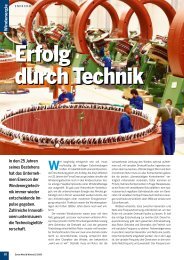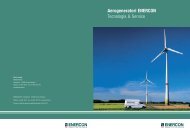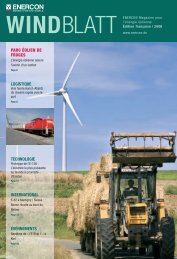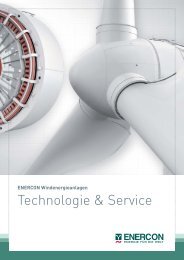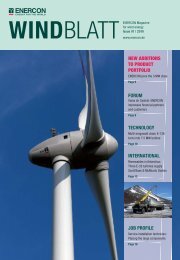title story... international technology job profiles energy ... - Enercon
title story... international technology job profiles energy ... - Enercon
title story... international technology job profiles energy ... - Enercon
Erfolgreiche ePaper selbst erstellen
Machen Sie aus Ihren PDF Publikationen ein blätterbares Flipbook mit unserer einzigartigen Google optimierten e-Paper Software.
WINDBLATT ENERCON<br />
Magazine<br />
for wind <strong>energy</strong><br />
Issue 01 | 2009<br />
www.enercon.de<br />
TITLE STORY...<br />
Headline<br />
Headline<br />
Page 6<br />
INTERNATIONAL<br />
Isle of Benbecula, Scotland:<br />
Repwowering in the<br />
Hebrides<br />
Page 8<br />
TECHNOLOGY<br />
Windgeneratorenfertigung:<br />
Neue Harztränke in<br />
Magdeburg<br />
Page 11<br />
JOB PROFILES<br />
WEC Service mechanics:<br />
Teams of two keep wind<br />
turbines up and running<br />
Page 12<br />
ENERGY POLICY<br />
EU-Klimapaket: Richtlinie für<br />
Erneuerbare einziger<br />
Lichtblick<br />
Page 16
ENERCON ADDRESSES<br />
INTERNATIONAL SALES OFFICES<br />
ENERCON GMBH, INTERNATIONAL DEPT.<br />
Otto-Lilienthal-Str. 25 · 28199 Bremen · Germany<br />
Phone +49 421 2441 510 · Fax +49 421 2441539<br />
e-mail: sales.<strong>international</strong>@enercon.de<br />
AUSTRIA<br />
ENERCON Austria Ges.mbH · Hauptstrasse 19<br />
2120 Wolkersdorf · AUSTRIA · Phone +43 2245 82828<br />
Fax +43 2245 82838 · e-mail: enercon@vienna.at<br />
BENELUX<br />
ENERCON Benelux BV · Paxtonstraat 1 a<br />
8013 RP Zwolle · THE NETHERLANDS<br />
Phone +31 38 4228 282 · Fax +31 38 4228 010<br />
e-mail: sales.benelux@enercon.de<br />
BRAZIL<br />
Wobben Windpower Ltda.<br />
Av. Fernando Stecca nº 100 · Distrito Industrial CEP 18087450<br />
Sorocaba · São Paulo · BRAZIL<br />
Phone +55 15 2101 1700 · Fax +55 15 2101 1701<br />
e-mail: wwp@wobben.com.br<br />
CANADA<br />
Michael Weidemann · ENERCON GmbH<br />
International Sales Department<br />
Oesterweg 9 · 59469 Ense · GERMANY<br />
Phone +49 2938 9720 17 · Fax +49 2938 9720 49<br />
e-mail: michael.weidemann@enercon.de<br />
DENMARK<br />
ENERCON Denmark<br />
Bredkær Parkvej 62 · 8250 Egaa · DENMARK<br />
Phone +45 87 430 388 · Fax +45 87 430 344<br />
e-mail: kristensen@enercon.de<br />
FRANCE<br />
ENERCON GmbH bureau français<br />
1, rue des Longues Raies · ZAC des Longues Raies<br />
F-60610 La Croix Saint Ouen · FRANCE<br />
Phone +33 3 44 83 67 20 · Fax + 33 3 44 83 67 29<br />
GREECE<br />
ENERCON Hellas S.A.<br />
20, Pentelis Avenue · 15235 Vrilissia, Athens · GREECE<br />
Phone +30 210 6838 490 · Fax +30 210 6838 489<br />
e-mail: enerconh@otenet.gr<br />
INDIA<br />
ENERCON India Ltd.<br />
Kolsite House, Plot No. 31 · Shah Industrial Estate<br />
Veera Desai Road, Andheri (West)<br />
Mumbai 400 053 · INDIA<br />
Phone +91 22 569 248 48 · Fax +91 22 267 300 85<br />
e-mail: info@enerconindia.net<br />
ITALY<br />
ENERCON Italia<br />
Via Luciano Manara, 5<br />
00044 Frascati (Roma) · ITALY<br />
Phone + 39 06 94 01 69 1 · Fax + 39 06 94 01 69 299<br />
e-mail: info@enerconitalia.it<br />
NEW ZEALAND<br />
ENERCON GmbH<br />
Andrea von Lindeiner · PO Box 340206<br />
Birkenhead · Auckland 0746 · NEW ZEALAND<br />
Phone +64 (0)9 4199 231 · GER +49 4941 976 959-147<br />
e-mail: andrea.vonlindeiner@enercon.de<br />
PORTUGAL<br />
ENERCON Portugal<br />
c/o Gellweiler S.A. · Rua Vitor Cordon, 37-4° Dt°<br />
1200-481 Lisboa · PORTUGAL<br />
Phone +351 21 340 71 65 · Fax +351 21 340 71 69<br />
e-mail: zgellweiler@gellweiler.pt<br />
SPAIN<br />
ENERCON Spain S.A.<br />
València Parc Tecnològic, Av. Juan de la Cierva, 27<br />
46980 Paterna (València) · SPAIN<br />
Phone +34 961 366 461 · Fax +34 961 366 469<br />
e-mail: enercon.spain@enercon.de<br />
SWEDEN<br />
ENERCON Energy Converter AB<br />
Stenåldersgatan 19<br />
21376 Malmö · SWEDEN<br />
Phone +46 40 143 580 · Fax +46 40 222 420<br />
e-mail: scandinavia@enercon.de<br />
TURKEY<br />
ENERCON Servis Ltd. Sti.<br />
Bagdat Cad. No 187 A Blok daire 5<br />
Selamicesme Kadikoy<br />
Istanbul · TURKEY<br />
Phone +90 216 3854 715 · Fax +90 216 3606 492<br />
e-mail: enercon@doruk.net.tr<br />
Page 3<br />
Page 4<br />
Page 6<br />
Page 8<br />
Page 10<br />
Page 11<br />
Page 12<br />
Page 14<br />
Page 16<br />
Page 2<br />
Page 7<br />
Editorial<br />
ENERCON News<br />
News from the ENERCON world<br />
Title Story<br />
Headline<br />
International<br />
Isle of Benbecula, Scotland: Repowering<br />
in the Hebrides<br />
Deutsch-Französische<br />
Koordinierungsstelle Windenergie:<br />
Mittlerin zwischen zwei<br />
großen Windenergiemärkten<br />
Technology<br />
Windgeneratorenfertigung: Neue<br />
Harztränke in Magdeburg<br />
Job Profiles<br />
Service mechanician for<br />
wind <strong>energy</strong> converters: Teams of two<br />
keep the mills turning<br />
Supplier<br />
Moeller GmbH: Experts in<br />
power distribution<br />
Energy Policy<br />
EU-Klimapaket: Richtlinie für<br />
Erneuerbare einziger Lichtblick<br />
Addresses & Events<br />
ENERCON Addresses<br />
Info-Service<br />
Imprint<br />
Publisher: ENERCON GmbH · Dreekamp 5 · 26605 Aurich · Germany<br />
Phone +49 4941 927-0 · Fax +49 4941 927-109 · www.enercon.de/en/_home.htm<br />
Editorial office: Volker Uphoff, Ruth Brand, Teelke Bojarski<br />
Printed by: Steinbacher Druck GmbH, Osnabrück, Germany<br />
Copyright: All photos, illustrations, texts, images, graphic representations, insofar as this is not expressly stated to the<br />
contrary, are the property of ENERCON GmbH and may not be reproduced, changed, transmitted or used otherwise without<br />
the prior written consent of ENERCON GmbH.<br />
Frequency: The WINDBLATT appears every three months and is regularly included in the “new <strong>energy</strong>”, magazine for renewable<br />
energies, of the German Wind<strong>energy</strong> Association.<br />
Subscribe: Phone +49 4941 976-667 or www.enercon.de/en/_home.htm.<br />
Cover photo: Faial wind farm, Azores (Portugal), consisting of four E-33/330 kW.
EDITORIAL WINDBLATT 01 | 2009 3<br />
Dear Readers,<br />
die Titelgeschichte dieses Windblatts zeigt die positiven Effekte der Entscheidung ENERCONS<br />
für ein Engagement in einem Land wie Portugal: Mit der laufenden Fertigstellung der letzten<br />
von ENERCON versprochenen Produktionslinien in Viana do Castelo wird Portugal vom Importeur<br />
zum Hersteller und Exporteur von Windenergieanlagen. Neben dem Umweltnutzen hat die<br />
Windenergie Jobs, Wirtschaftswachstum und Aufträge für viele portugiesische Firmen gebracht.<br />
Zugleich kann ENERCON mit den neuen Kapazitäten die weltweite Nachfrage nach seinen<br />
Windanlagen bedienen.<br />
Die Richtlinie für erneuerbare Energien ist der bislang wohl ambitionierteste Schritt der Europäischen<br />
Union zur Begrenzung des Klimawandels: Im Jahr 2020 müssen in Europa mindestens<br />
20 % des Bruttoendenergieverbrauchs aus erneuerbaren Quellen stammen. Jeder Mitgliedstaat<br />
erhalten dazu eine rechtlich bindende Zielvorgabe (detailliert sind die Vorgaben<br />
eigentlich nicht, es ist halt eine Zahl pro Land). Auf dem Weg dahin müssen sie Zwischenziele<br />
erreichen, die die EU-Kommission überprüft. Wie die Länder das schaffen, ist ihre Sache:<br />
Über die geeigneten Instrumente entscheiden sie allein. Dies ist ein schöner Erfolg, weil bewährte<br />
nationale Fördermechanismen für erneuerbare Energien wie das deutsche EEG nun<br />
entgegen den ursprünglichen Kommissionsplänen unangetastet bleiben.<br />
Wichtig für Fortschritte bei den Erneuerbaren sind die Textpassagen zum Netzausbau. Alle EU-<br />
Mitglieder “müssen geeigneten Schritte unternehmen” damit die für den Ausbau der regenerativen<br />
Stromerzeugung nötigen Übertragungs- und Verteilnetze zur Verfügung stehen, heißt<br />
es. Auch der Netzanschluss und der Einsatz von Speichersystemen für regenerative Energieanlagen<br />
sind zu unterstützten. Ein prioritärer Netzzugang für Regenerativ-Erzeuger und die Reservierung<br />
von Anschlusskapazitäten für Erneuerbare werden ausdrücklich als Optionen zur<br />
Beschleunigung des Ausbaus vorgeschlagen. Das Erzeugungsmanagement – schon heute ein<br />
wachsendes Ärgernis für die Windmüller Schleswig-Holsteins – soll dadurch aufhören und<br />
sich nur noch auf absolute Notfälle beschränken. Die Richtlinie verpflichtet die Netzbetreiber<br />
hier zur Rechenschaft gegenüber einer Regulierungsbehörde. Das wird vor allem Windmüller<br />
in den EU-Ländern mit hohem regenerativem Stromanteil freuen. Die Netzbetreiber sind am<br />
Zuge! Sie müssen ihre Netze so gestalten, dass sie die dezentrale Stromproduktion aus erneuerbaren<br />
Quellen aufnehmen können.<br />
Yours sincerely<br />
Aloys Wobben<br />
Managing Director ENERCON GmbH
Picture: Herbert Grabe<br />
4 WINDBLATT 01 | 2009 NEWS<br />
Sowing wind and reaping power –<br />
Bavaria coming on board!<br />
Audience of Bavarian wind industry convention.<br />
At the first Bavarian wind industry convention<br />
in Regensburg, more than 40 suppliers used<br />
the opportunity to network with other medium-sized<br />
enterprises and thus strengthen the<br />
wind industry community in Bavaria. Together,<br />
participants will promote a more extensive exploitation<br />
of the huge wind potential in this<br />
part of Germany that has largely been lying<br />
dormant so far.<br />
“The E-82 in particular makes the development<br />
of many sites in southern Germany viable”,<br />
explained Joachim Keuerleber, ENERCON<br />
sales manager for southern Germany, at the<br />
convention. There is one crucial argument in<br />
favour of wind power generation in southern<br />
Germany: The production costs are fixed for<br />
20 years. This is all the more important when<br />
comparing these costs to the prices charged<br />
by the large power producers. Whereas the<br />
German feed-in law defines a fixed tariff of<br />
9.2 ct./kWh from 2009 on, the regional utilities<br />
who do not produce their own electricity have<br />
to contend with the continuous price increases<br />
imposed by the large power producers,<br />
even with fuel costs currently in decline.<br />
But in order to create a domestic market for<br />
the strong Bavarian wind industry, the Bavarian<br />
state government needs to act, says Keuerleber.<br />
The current government coalition in<br />
Munich has after all agreed to increase the renewables<br />
share in power generation from<br />
20 % today to 30 % by 2020. Says Keuerleber:<br />
“Without a major contribution by the wind<br />
<strong>energy</strong> sector, they will not be able to reach<br />
this goal.”<br />
Some municipalities are already doing pioneering<br />
work: For example, the town of Vilsbiburg<br />
near the Austrian border has decided to start<br />
producing their own clean <strong>energy</strong>. They are<br />
planning to build an E-82 turbine with 138 m<br />
hub height projected to produce more than 4<br />
million KWh per year. This alone will provide<br />
10 % of the <strong>energy</strong> consumption by the town's<br />
11,000 inhabitants. At the wind <strong>energy</strong> convention,<br />
Vilsbiburg mayor Helmut Haider was<br />
looking even further ahead. If the E-82 proves<br />
itself, more wind <strong>energy</strong> converters will follow<br />
in which residents of the region will be able to<br />
acquire shares.<br />
“This way, wind <strong>energy</strong> will finally boost the<br />
local economy in Bavaria. So far, it has only<br />
helped to finance the wind <strong>energy</strong> generation<br />
in northern Germany based on the redistribution<br />
system defined by the Renewables Act”,<br />
says ENERCON sales director Keuerleber.<br />
Lithuania: Sudenai/Lindemai wind<br />
farm taken over by customer<br />
Sudenai wind farm in West Lithuania.<br />
Im Dezember hat ENERCON den Windpark Sudenai<br />
in Litauen dem Betreiber “4 Energia”<br />
übergeben. Der Park besteht aus sieben<br />
E-82/2 MW auf 77 Meter hohen Stahltürmen.<br />
Der Standort erstreckt sich über das Gebiet<br />
zweier Gemeinden im westlitauischen Bezirk<br />
Kretingos: Sudenai und Lendimai. Vier Anlagen<br />
stehen im ersten, drei am zweiten Ort. “Es<br />
handelt sich eigentlich um zwei Teilwindparks,<br />
die wir 2006 übernommen und zusammengeführt<br />
haben”, berichtet Andrus Zavadskis,<br />
Technischer Direktor von “4 Energia” mit Sitz<br />
in Tallin, Estland. Die Firma vertritt die Interessen<br />
der Eigentümergesellschaften AS Fre<strong>energy</strong><br />
und AS Vardar Eurus, die Finanzierung sichern<br />
baltische Dependancen der SEB und<br />
Hansabank/Swedbank.<br />
Der Windpark liegt nur zehn Kilometer von der<br />
Ostseeküste entfernt, nahe der lettischen<br />
Grenze. Das Areal umfasst mehr als 38 Hektar<br />
und wird von einer 110 kV-Kabel Trasse<br />
durchschnitten. Über einen gemeinsamen Einspeisepunkt<br />
sind beide Teilparks daran angeschlossen.<br />
Stromabnehmer ist der litauische<br />
Netzbetreiber AB Lietuvos Energija, der die gesetzlich<br />
festgesetzten 8,7 Ct. je kWh Vergütung<br />
über 20 Jahre zahlt.<br />
Die Prognose sagt für die E-82 rund 3000 Volllaststunden<br />
pro Jahr voraus, ein auch im <strong>international</strong>en<br />
Vergleich guter Standort also.<br />
“Wir erwarten einen Jahresertrag von 41 Millionen<br />
kWh ”, so Zavadskis. “Der Park soll Litauen<br />
dabei unterstützen, seinen erneuerbaren<br />
Energieanteil zu steigern.” Derzeit werden<br />
in dem Land nur 3,5 % des Strombedarfs aus<br />
erneuerbaren Energiequellen gedeckt, bis<br />
2010 will die Regierung den Anteil auf 10 %<br />
steigern. Dazu bräuchte es laut “4 Energia”<br />
rund 200 MW Windenergie.<br />
Erst im Oktober hatte “4 Energia” den E-70<br />
Windpark “Virtsu 2” im Westen Estlands feierlich<br />
eingeweiht: Mehr als 100 Gäste waren gekommen,<br />
darunter der estische Umweltminister<br />
Jaanus Tamkivi, Vertreter diverser<br />
Parteien und Lokalpolitiker. Virtsu 2 befindet<br />
sich auf einer Landzunge, die sich erst vor anderthalb<br />
Jahrtausenden aus der Ostsee erhoben<br />
hat. In Virtsus legen die Fähren zur größten<br />
estischen Insel Saareema ab (über Muhu).<br />
Für die drei E-70 ist ein Ertrag von 21 Mio.<br />
kWh p.a. prognostiziert. Abnehmer des Stroms<br />
ist Latvenergo, der lettische Versorger.<br />
Martin Kruus, ehemaliger Manager für Erneuerbare-Energien-Projekte<br />
des staatlichen Energieversorgers<br />
Estonian Energy ltd. (Eesti Energia),<br />
hat “4 Energia” Ende 2005 gegründet.<br />
Die Firma beschäftigt inzwischen 10 Mitarbei-
ter und betreibt im Baltikum sechs Windparks<br />
mit einer Leistung von 120 MW. Die “vier” im<br />
Namen steht für die Geschäftsfelder Wasser,<br />
Wind, Sonne und Biomasse – obwohl der<br />
Schwerpunkt auf absehbare Zeit bei der Windenergie<br />
liegt. On shore verfolgt “4 Energia”<br />
zurzeit Planungen für über 250 MW Windenergie<br />
im Baltikum. Aktuell entstehen weitere Projekte<br />
mit ENERCON in Tooma, Estland (6 E-82)<br />
und Mockiai, Litauen, wo in diesem Jahr 12<br />
MW – E-82 erstmals im Baltikum auf 108 m<br />
Betontürmen – aufgebaut werden.<br />
ENERCON Kunden gewinnen Tender<br />
auf den Kanaren<br />
E-33 on Gran Canaria.<br />
Windpark-Projekte, die mit ENERCON Turbinen<br />
planen, haben bei aktuellen Ausschreibungen<br />
auf den Canarischen Inseln offenbar besonders<br />
gute Chancen gehabt. Das zeichnet sich<br />
nach Veröffentlichung der Ausschreibungsergebnisse<br />
auf drei von sechs Inseln ab.<br />
Auf La Palma, Lanzarote und La Gomera waren<br />
insgesamt Anschlusskapazitäten für 48<br />
MW Windenergie ausgeschrieben. Projektierer,<br />
die mit ENERCON planen, konnten sich das<br />
gesamte Volumen sichern. “Auch auf den anderen<br />
Inseln haben wir sehr gute Karten: Das<br />
liegt daran, dass unsere Anlagen die Kriterien<br />
der Ausschreibung besonders gut erfüllen”,<br />
erläutert Thomas Barkmann, regionalverantwortlicher<br />
Vertriebsmitarbeiter bei ENERCON<br />
International in Bremen. So habe auf den In-<br />
seln aufgrund der kleinen Versorgungsnetze<br />
die Netzverträglichkeit eine besondere Rolle<br />
gespielt.<br />
Hier können ENERCON WEA punkten, weil sie<br />
über eine Wirkleistungsregelung verfügen,<br />
Blindleistung innerhalb vorgegebener Zeiten<br />
sicher zur Verfügung stellen und Netzfehler<br />
durchfahren können. “Die ENERCON Technologie<br />
- Farm Control Unit - erlaubt darüber hinaus<br />
eine intensive Kommunikation zwischen<br />
Anlage und Netzregelung”, erläutert Eckhard<br />
Quitmann, zuständig für den Technical Support<br />
im <strong>international</strong>en Vertrieb.<br />
Die Windparks sollen möglichst großen Abstand<br />
zu Naturschutzflächen einhalten: “Wegen<br />
des effizenten Rotorblattdesigns erzielen<br />
ENERCON WEA einen optimalen Ertrag auf den<br />
begrenzten Flächen”, so Barkmann. Die Entfernung<br />
zu den Schutzgebieten kann so optimal<br />
gestaltet werden. Insgesamt sind auf den<br />
Kanaren 440 MW Windenergie-Leistung ausgeschrieben:<br />
Die Publikationen der Ergebnisse<br />
durch die Kommunalverwaltungen auf den<br />
großen Inseln Gran Canaria, Fuerteventura<br />
und Teneriffa werden für Februar erwartet.<br />
Energy Watch Group: 100 %<br />
erneuerbare Stromversorgung bis<br />
2040 machbar<br />
Die weltweit installierte Windenergieleistung<br />
wird sich in den nächsten drei Jahren von 120<br />
GW (Ende 2008) auf 240 GW verdoppeln. Zu<br />
diesem Ergebnis kommt eine Studie im Verbund<br />
der unabhängigen Energy Watch Group,<br />
Sitz Berlin, die vier verschiedene Wachstumspfade<br />
in der Energieversorgung bezüglich ihrer<br />
Konsequenzen für die Windstromerzeugung<br />
untersucht hat.<br />
Im vergangenen Jahrzehnt ist die Windenergie<br />
gemessen an der installierten Leistung jährlich<br />
um 30 % gewachsen. Eine Fortsetzung dieser<br />
Entwicklung – untersucht in zwei der vier<br />
Szenarien – führt dazu, dass WEA 2025 zwischen<br />
11.400 und 16.400 Terawattstunden<br />
Strom erzeugen. Auch bei höherem Verbrauchsanstieg<br />
(+ 3,6 % p.a.) würde der<br />
Strom aus Erneuerbaren, vor allem Wind und<br />
Solar, den konventionell erzeugten Strom da-<br />
NEWS WINDBLATT 01 | 2009 5<br />
Rudolf Rechsteiner, author the EWG study.<br />
mit bereits übertreffen (Anteil >50 %). Bei einem<br />
moderaten Verbrauchsanstieg (+1,8 %<br />
p.a.) betrüge der regenerative Anteil sogar<br />
77 %. Halbierten sich die Wachstumsraten bei<br />
der Windenergie auf +15,2 % p.a. – was die<br />
übrigen Szenarien untersuchen – würde die<br />
Elektrizität aus Erneuerbaren 2025 immer<br />
noch einen Anteil zwischen 23 % und 32 % erreichen.<br />
Bis 2040 soll laut der Studie sogar eine<br />
vollständige Versorgung mit Elektrizität aus<br />
erneuerbaren Energien realistisch sein.<br />
Die Energy Watch Group setzt einen Kontrapunkt<br />
zu den Szenarien der Internationalen Energieagentur<br />
(IEA), die von einem erheblich<br />
niedrigeren Basiswachstum sowie einem Einbruch<br />
bei der Neuinstallation in der Mitte des<br />
zweiten Jahrzehnts ausgehen. “Die IEA-Vorhersagen<br />
sind zu pessimistisch. Die tatsächlich<br />
installierte kumulierte Windenergieleistung<br />
betrug 2007 das Vierfache der durchschnittlichen<br />
Schätzungen aller IEA World Energy Outlooks<br />
zwischen 1995 und 2004”, sagt der Autor<br />
der Studie, Dr. Rudolf Rechsteiner.<br />
Er betont, der Windenergieausbau hänge anders<br />
als von der IEA angenommen nicht nur<br />
von den Kosten für die fossilen Energieträger<br />
ab sowie den angeblichen nuklearen Kostenvorteilen:<br />
Eine gewichtige Rolle spielten auch<br />
die freie Erschließbarkeit von Windressourcen,<br />
die Möglichkeit, Risiken der Brennstoffpreisentwicklung<br />
zu umgehen, neue Regulierungen<br />
für den Netzbetrieb sowie ein weltweites<br />
Marktwachstum aufgrund immer besserer<br />
und günstigerer Windtechnologie.
6 WINDBLATT 01 | 2009 TITLE STORY<br />
Kicker<br />
Portugal
TITLE STORY WINDBLATT 01 | 2009 7<br />
EWEC 2009<br />
(Marseille/Frankreich)<br />
16.03. – 19.03.09<br />
Europäische Konferenz<br />
und Messe zur Windenergie<br />
(ENERCON in Halle 1, St. 1427)<br />
www.ewec2009.info<br />
New Zealand Wind Energy<br />
Conference 2009<br />
(Wellington/Neuseeland)<br />
20.04. – 22.04.09<br />
Konferenz und Messe zur<br />
Windenergie in Neussland<br />
www.wind<strong>energy</strong>.org.nz<br />
ENERGY<br />
auf der Hannover Messe<br />
(Hannover/Deutschland)<br />
20.04. – 24.04.09<br />
Technologiemesse für den<br />
Energiemix der Zukunft<br />
www.hannoverfair.de<br />
PWEA Konferenz 2009<br />
(Warschau/Polen)<br />
21.04. – 22.04.2009<br />
Konferenz zum<br />
Windenergie-Markt Polen<br />
www.conference2009.pwea.pl<br />
All-Energy<br />
(Aberdeen/Großbritannien)<br />
20.05. – 21.05.09<br />
Ausstellung und Konferenz zu<br />
erneuerbaren Energien<br />
(ENERCON an Stand 26, im<br />
Exhibition & Conference Center)<br />
www.all-<strong>energy</strong>.co.uk<br />
INFO-SERVICE
8 WINDBLATT 01 | 2009 INTERNATIONAL<br />
Isle of Benbecula, Scotland<br />
Repowering in the Hebrides<br />
Last November in Liniclate on the Hebridean island of Benbecula,<br />
a new E-44/900kW wind <strong>energy</strong> converter went on the grid. WEC<br />
operator Charlie Robb realised one of the UK’s first repowering<br />
projects at this site. Pupils in the nearby Sgoil Lionacleit secondary<br />
school will soon be able to track the turbine’s operation in class via<br />
the ENERCON remote monitoring system.<br />
In 1990, the Windharvester/60kW was the<br />
first wind <strong>energy</strong> project in the UK designed<br />
to supply power to a school and a community<br />
centre. (Since then, renewable <strong>energy</strong><br />
systems have almost become a fashion<br />
among environmentally conscious schools<br />
in the UK.) The wind turbine in combination<br />
with diesel generators was intended to<br />
create a stand-alone system during grid power<br />
cuts. “There was even a system to<br />
divert excess wind power to heat the swimming<br />
pool”, explains Robb. But unfortunately,<br />
the wind-diesel system never worked<br />
properly due to problems with the control<br />
system. “The council and the school had a<br />
lot of difficulty keeping the machine run-<br />
ning, and total yield in the first eight years<br />
of operation amounted to only 200 MWh”,<br />
explains Robb. In the late 1990s, Sgoil Lionacleit<br />
had given up and the turbine was<br />
standing idle.<br />
At the time, Robb was working as electrical<br />
engineer for a company specialising in renewable<br />
<strong>energy</strong> grid connection. “But I really<br />
wanted own and operate a wind power system”,<br />
says Robb. When he heard of the<br />
Windharvester in Liniclate, he seized the opportunity:<br />
He bought the defective turbine<br />
and rented the site. He replaced the gearbox<br />
and modified the control system. “In those<br />
nine years that I operated and maintained<br />
The E-44 in Liniclate on the Isle of Benbecula in the Atlantic ocean, 60 km west of the Scottish mainland.<br />
the Windharvester, it produced 1 GWh of electricity”,<br />
Robb says proudly. Towards the<br />
end, he even replaced the entire nacelle<br />
with a used nacelle from another WEC.<br />
One of the first repowering<br />
projects in the UK<br />
In 2003, Robb started the process of obtaining<br />
a planning consent and a grid connection<br />
for a bigger turbine. There is limited<br />
grid capacity available for private power generators<br />
in the West of Scotland. Says Robb:<br />
“The grid-friendly aspects of the ENERCON<br />
turbine were definitely in my favour when<br />
negotiating with regional utility Scottish &<br />
Southern Energy.” It was a long, slow process,<br />
but eventually at the end of 2007,<br />
Robb had everything in place including a<br />
commitment from ENERCON to supply the<br />
turbine. Based on his experience with different<br />
makes of turbines with gearboxes and<br />
the difficulties he suffered with his own machine,<br />
he was particularly keen on<br />
ENERCON’s direct drive concept.<br />
Robb’s persistence resulted in the realisation<br />
of one of the first repowering projects in<br />
the entire UK, and ENERCON’s first installation<br />
of an E-44/900kW there.<br />
Access to SCADA for local school<br />
He did have to give up supplying power directly<br />
to the school and the community centre,<br />
though. “For the bigger turbine, we needed<br />
a new connection directly to the 11kV<br />
medium-voltage grid; this meant there was<br />
no way to keep supplying the school directly<br />
at the low-voltage level.” To compensate<br />
the council for this loss, Robb now pays a<br />
higher rental fee.<br />
Charlie Robb and ENERCON will provide the<br />
secondary school with access to the remote<br />
monitoring system via SCADA. “This will<br />
be a really useful tool for the physics and<br />
engineering classes.” The school will also
A group of pupils visiting the E-44 on Benbecula.<br />
set up specific renewable <strong>energy</strong> lessons,<br />
says Robb. He himself has already agreed<br />
to lecture groups on the subject.<br />
Benbecula is part of a chain of islands<br />
connected by causeways, known as Uist.<br />
The power grid is normally supplied by undersea<br />
cable from the mainland. But there<br />
is also a large oil-fired power station which<br />
can support the grid or run it stand-alone, if<br />
necessary. About 7,000 people live on the<br />
islands. A lot of people work in the public<br />
service sector: Administration, hospitals,<br />
schools, and military installations. There is<br />
also a high proportion of retired people. Industries<br />
include fish farming and some<br />
agriculture.<br />
Wind conditions on the islands are simply<br />
excellent: At the Liniclate site, the wind assessment<br />
produced an estimate of 8.5m/s<br />
on average, at 55m hub height. “In its first<br />
two weeks of operation, the new turbine generated<br />
175 MWh – that’s the same as the<br />
old turbine generated in a whole year!”<br />
“It is unusual in the UK for an individual who<br />
does not own the land to be able to get all<br />
the way through the process of permits, financing<br />
and installation of a project of this<br />
size”, says Robb. Normally there would be<br />
other equity partners investing in a project<br />
of this size. “The project benefited from the<br />
fact that there was an existing machine on<br />
site. I was also very fortunate to get loan<br />
financing from the Cooperative Bank in<br />
Manchester. I considered different options<br />
including local community investment but it<br />
was not required in the end.”<br />
Success of a one-man-business<br />
Robb’s one-man business takes care of renewable<br />
<strong>energy</strong> installations around Scotland.<br />
“I have installed many wind turbines,<br />
photovoltaic systems, and hydropower turbines<br />
that I now maintain, in particular for<br />
schools and village halls on the western islands.<br />
I am now involved in various proposed<br />
community wind farm projects.” The local<br />
community, too, may soon become a<br />
wind farm operator. According to Robb, they<br />
are planning a wind farm development of<br />
their own on South Uist.<br />
Robin Borgert, ENERCON sales representative<br />
for the UK, emphasises how superbly<br />
the ENERCON logistics department handled<br />
the challenges inherent to the project: “All<br />
components and cranes had to be shipped<br />
to the construction site via small car ferries,<br />
INTERNATIONAL WINDBLATT 01 | 2009 9<br />
and everything was on time. It was a real<br />
precision <strong>job</strong>!” Another great compliment<br />
goes to installation supervisor Sieghard<br />
Saathoff. “The team arrived, took care of<br />
the <strong>job</strong>, and finished up in less than five<br />
days: A picture-perfect installation at a<br />
strong-wind site in November!”<br />
Charlie Robb.
10 WINDBLATT 01 | 2009 INTERNATIONAL<br />
Deutsch-Französische Koordinierungsstelle Windenergie<br />
Mittlerin zwischen zwei<br />
großen Windenergiemärkten<br />
Die deutsch-französische Koordinierungsstelle<br />
Windenergie e.V. hat in Laure Kaelble seit<br />
August eine neue Leiterin. Die 31jährige sieht<br />
die Aufgabe des Vereins in der Vermittlung von<br />
Informationen und Kontakten, die es den beteiligten<br />
Akteuren ermöglichen, die<br />
Windenergie in Deutschland und Frankreich<br />
weiter voranzutreiben. “Unsere Aufgabe ist es<br />
nicht, die Genehmigungsverfahren in beiden<br />
Ländern anzugleichen. Wir möchten vielmehr<br />
erreichen, dass sich das Fachpublikum über<br />
die Prozesse im jeweils anderen Land genau<br />
informieren kann”, sagt sie. Laure Kälble im Büro des Vereins im Berliner Umweltministerium.<br />
Windblatt: Frau Kaelble, Sie sind seit einem<br />
halben Jahr die Leiterin der Koordinationsstelle.<br />
Wo liegen die Schwerpunkte<br />
Ihrer Arbeit?<br />
Kaelble: Ich möchte das Angebot für unsere<br />
Mitglieder – Ministerien, Verbände, Hersteller,<br />
Projektierer, Finanzierer und Rechtsanwälte<br />
– weiter professionalisieren. Im<br />
Zentrum stehen die Konferenzen und Seminare:<br />
Themen sind in diesem Jahr u.a.<br />
Raumordnung für Windenergie, Beschäftigung<br />
und Ausbildung sowie Genehmigungsverfahren.<br />
Außerdem möchten wir<br />
unsere Mitglieder besser vernetzen und der<br />
externen Kommunikation ein neues Gesicht<br />
geben: So gibt es im März ein Relaunch unsere<br />
Internetseiten.<br />
Windblatt: Welchen Beitrag können Sie zur<br />
positiven Kommunikation über Windenergie<br />
in beiden Ländern leisten?<br />
Kaelble: Wir möchten eine möglichst breite<br />
Akzeptanz für Windenergie in Deutschland<br />
und Frankreich erreichen, indem wir das<br />
Fachpublikum und unsere Medienpartner<br />
mit “best practice”-Beispielen in beiden<br />
Ländern vertraut machen – damit sie Inspiration<br />
schöpfen. Das geschieht sowohl<br />
durch die Seminare und die Kommunikation<br />
ihrer Ergebnisse als auch durch Vermittlung<br />
von Ansprechpartnern in beiden Ländern,<br />
z.B. für Expertisen, die die Medien benötigen,<br />
oder für Unternehmenskooperationen.<br />
Windblatt: Wie sehen Sie die Rolle ihres<br />
Vereins zwischen den Verbänden?<br />
Kaelble: Der BWE und SER/FEE sind unsere<br />
zentralen Partner, ohne deren Unterstützung<br />
wir nicht arbeiten können. Sie standen<br />
gemeinsam mit den Ministerien für Umwelt<br />
in Deutschland und für Industrie in Frankreich<br />
an der Wiege unserer Initiative. Die Arbeitsteilung<br />
lässt sich gut an der Akzeptanz<br />
verdeutlichen: Für eine bessere öffentliche<br />
Akzeptanz von Windenergie werben die Firmen<br />
und Verbände. Wir sorgen dafür, dass<br />
die Verbesserung der Akzeptanz Thema im<br />
deutsch-französischen Austausch wird.<br />
Windblatt: Wie können Sie sicherstellen,<br />
dass die Dialoge, die sie anstoßen, auf ministerieller<br />
Eberne weitergeführt werden?<br />
Kaelble: Indem wir vermehrt Abteilungsbzw.<br />
Referatsleiter aus den Ministerien zur<br />
Teilnahme an unseren Veranstaltungen bewegen<br />
und sie als Referenten und Diskussionsteilnhemer<br />
gewinnen. Wir dringen zudem<br />
verstärkt darauf, dass die Referenten<br />
nicht nur über das eigene Land sprechen,<br />
sondern immer auch das andere mit einbeziehen.<br />
Auch eine bessere Nachbereitung –<br />
Übersetzung von Präsentationen, das Zur-<br />
Verfügung-Stellen von Vertiefungen sowie<br />
aktuellen Infos aus Forschungsprojekten<br />
der Konferenzen – wird hilfreich sein.<br />
Windblatt: Wo sehen Sie die größten Unterschiede<br />
bei der Windenergie in<br />
Deutschland und Frankreich?<br />
Kaelble: In Deutschland gibt es eine weltweit<br />
führende Windindustrie und bereits<br />
sehr viel installierte Leistung. In Frankreich<br />
ist das Potenzial noch enorm. Während man<br />
sich in Deutschland fragt, wie man weiter<br />
wachsen kann und Repowering ein Thema<br />
ist, sorgt man sich in Frankreich vor allem<br />
um eine vernünftige Planung, um Akzeptanzprobleme<br />
zu vermeiden.
Windgeneratorenfertigung<br />
Neue Harztränke<br />
in Magdeburg<br />
ENERCON hat in Magdeburg-Rothensee, Sachsen-Anhalt, eine<br />
neue Imprägnieranlage für E-70/E-82-Generatoren in<br />
Betrieb genommen. Der Auftrag des Harzes stabilisiert die<br />
Kupferwicklungen und Elektrobleche in Rotor und Stator<br />
und dämpft Geräusche. “Unsere weltweite Tränkkapazität<br />
hat sich damit mehr als verdoppelt”, sagt Matthias Dutsch,<br />
Geschäftsführer der Induction Generatorenfertigung in<br />
Aurich. Bis zu 2500 Generatoren können nun pro Jahr allein<br />
in Magdeburg imprägniert werden. Außerdem verbessert die<br />
neue Anlage die Arbeitsqualität: Das Ein- und Ausfahren der<br />
Werkstücke zur Tränke sowie das Beschicken der Öfen für<br />
das Vorwärmen und Härten erfolgen vollautomatisch.<br />
In den Hallen der Rothenseer Generatorenfertigung<br />
wickeln pro Schicht rund 80 Mitarbeiter<br />
Rotoren und Statoren. Wenn ein<br />
Werkstück fertig gewickelt ist, stellen die<br />
Mitarbeiter es auf dem Vorplatz der Imprägnieranlage<br />
auf speziellen Traggestellen ab.<br />
Zwei der insgesamt drei Mitarbeiter im Imprägnierbereich<br />
begleiten den Rotor auf<br />
seiner Fahrt: Einer tippt die Angaben zu Typ,<br />
Seriennummer und Platz in die Anlagensteuerung<br />
ein. Daraufhin holt ein Querverschiebewagen<br />
den Rotor ab und bringt ihn<br />
Vollautomatisch Pulverbeschichtungsanlage in Rothensee.<br />
in einen von drei Öfen für das Vorwärmen<br />
vor und das Aushärten nach der Tränke. Die<br />
Ofentore öffnen und schließen sich automatisch,<br />
die Kontakte für das Erwärmen mit<br />
Strom legen sich von selbst an. Das Vorwärmen<br />
dauert etwa eine Stunde.<br />
An der Tränke bedienen die Mitarbeiter<br />
dann einen Kran, um den Rotor vom Träger<br />
umzuheben. Der Rotor senkt sich in die<br />
leere Tränke, die mit 2,5 m 3 monomerfreiem<br />
Harz geflutet wird. Der Harzspiegel steigt<br />
bis über die Polschuhe.<br />
Wenn es mit den<br />
heißen Kupferwicklungen<br />
und Stahlblechen<br />
in Kontakt tritt,<br />
verflüssigt sich das<br />
zähe Harz und breitet<br />
sich bis in die tiefsten<br />
Kupferwicklungen<br />
hinein aus. Der<br />
Hauptgurt des Rotors<br />
liegt an einem Abdichtring<br />
in der Wanne<br />
an: So kann das<br />
Harz nicht in den Innenbereich<br />
des Ro-<br />
TECHNOLOGY WINDBLATT 01 | 2009 11<br />
Rotor vor dem Einheben in die Tränke, rechts die Statortränke.<br />
tors fließen. Nach dem Bad tropft das Werkstück<br />
40 Minuten lang ab und geht dann<br />
zum Aushärten in den Ofen.<br />
“Das Harz bildet einen geleeartigen Überzug<br />
auf Kupferwicklungen und Elektroblechen.<br />
Es sorgt für Stabilität und dämpft die<br />
Geräuschentwicklung”, erläutert Wolfgang<br />
Benack, Geschäftsführer der Windgeneratorenfertigung<br />
in Magdeburg. Um das Harz<br />
und den Stahlbau des Generators vor<br />
Feuchtigkeit zu schützen, trägt zuletzt ein<br />
Roboter in einer mit Glaswänden abgeschirmten<br />
Kabine Expoid-Pulver auf. Dieses<br />
schmilzt auf den warmen Werkstücken und<br />
bildet eine 200 µm dicke Lackschicht.<br />
“Den höheren Durchsatz im Vergleich zu älteren<br />
Tränken erreichen wir durch Automation<br />
und Parallelbetrieb von drei Öfen”, sagt<br />
Cord Druivenga, Betriebsmittelkonstrukteur<br />
bei ENERCON. Die Automatisierung sichert<br />
die gleichbleibende Qualität. Zugleich erhöht<br />
sich die Arbeitssicherheit: Der automatische<br />
Transport sorgt zusammen mit<br />
dem Einsatz von Arbeitsbühnen dafür, dass<br />
die Bediener von den Prozessen in den<br />
Tränken und Öfen abgeschirmt sind.
12 WINDBLATT 01 | 2009 JOB PROFILES<br />
WEC Service mechanics<br />
Teams of two keep wind<br />
turbines up and running<br />
ENERCON Service mechanic –<br />
a diversified <strong>job</strong> for proactive<br />
people: After completing the<br />
initial training they are posted<br />
to one of the ENERCON Service<br />
stations located in close<br />
proximity of ENERCON<br />
installations. In collaboration<br />
with the electronics engineers,<br />
their task is to ensure that<br />
ENERCON wind turbines remain<br />
in good working order. Excellent<br />
insight to turbine mechanics<br />
and an ability to pinpoint<br />
possible sources of error are<br />
essential qualities.<br />
“Three quarters of our time are devoted to<br />
regular maintenance checks on the WECs.<br />
In addition to that, we support the electronics<br />
engineers in troubleshooting fault messages,<br />
carry out maintenance on new installations<br />
after the initial 300 hours of<br />
operation and look after updating machines”,<br />
says Thomas Kersten who has been a<br />
mechanic at the ENERCON Service station<br />
in Sulingen, German state Lower Saxony,<br />
for the past six years.<br />
Team briefing at the station<br />
The five Sulingen teams (ENERCON Service<br />
technicians always work in teams of two)<br />
meet in the morning at a former joiner’s<br />
workshop transformed into a storage depot<br />
to organize their maintenance schedule and,<br />
whenever necessary, decide on the order of<br />
priority for some 130 WECs in their vicinity.<br />
Wind turbines that may risk an unwanted<br />
shutdown are always at the top of the list.<br />
Torsten Gräpel doing maintenance work in an E-82 spinner.<br />
“Our machines are designed to run for at<br />
least 20 years. So it’s our <strong>job</strong> to locate and<br />
troubleshoot any problems before they happen<br />
to prevent loss of revenue”, explains<br />
Kersten. The WECs are regularly checked<br />
every three months. At the base of the machine,<br />
Kersten and his team partner, Torsten<br />
Gräpel, inspect the foundation, lift, ladders<br />
and tower door. A visual check is performed<br />
on the control cabinet panels. They make<br />
sure that the rotor emergency stop button is<br />
in proper working order and test if it is possible<br />
to pitch the blades from the tower base<br />
position.<br />
Servicing a WEC machine house<br />
Up top, in the nacelle, visual grease checks<br />
are on the agenda. Bolts and fasteners need<br />
to be checked, generator measurements taken<br />
and drives inspected. “If anything is<br />
out of whack on the motors, you can usually<br />
hear it during a test start up.” Kersten<br />
talks about the occasional bolt replacement<br />
and rare occasions when pitch and yaw drives<br />
have to be replaced.<br />
Working on the 500 kg yaw drive is a tricky<br />
<strong>job</strong>. If it has to be repaired, the team orders<br />
an elevator work platform through the central<br />
Service office in Aurich. Usually, the crane<br />
trolley arrives the next day. At the rear of<br />
the nacelle, a winch is used to hoist all the<br />
necessary gear up through the hatch. Space<br />
is limited in the nacelle so precision work<br />
and sometimes even a bit of improvisation<br />
is called for.<br />
Working at heights<br />
“Friends and other people I talk to always<br />
ask me whether working at such high<br />
heights is not too dangerous”, explains Kersten<br />
who is now an old hand at the <strong>job</strong>.<br />
“I tell them, ENERCON has developed a<br />
well-thought-out safety system and as long
as you stick to the regulations, it’s the safest<br />
workplace in the world.”<br />
For the two mechanics, working at heights<br />
is not just routine. Kersten confesses in the<br />
first few years of service, when the weather<br />
was good, he and his team mate used to<br />
fight over the best look out spot – the service<br />
hatch leading out onto the top of the<br />
nacelle. “Now I think I know every detail of<br />
the countryside around Sulingen from a<br />
birds eye view.” Almost two thirds of the<br />
ENERCON WECs around Sulingen are 2 MW<br />
machines meaning that the towers are up<br />
to 138 metres high and usually equipped<br />
with a lift. “Our sector is actually quite comfortable:<br />
There are only about a dozen<br />
E-40s and six E-60s where we still have to<br />
access the machine house using the safety<br />
ladder”. says Kersten.<br />
From machine engineering to<br />
ENERCON Service<br />
The 40 year old is married, father of two<br />
children and owns his own house in Sulingen.<br />
Before joining ENERCON, he worked in<br />
the machine construction sector. “I used to<br />
work for the industry and service providers<br />
making conveyors for glass factories, test<br />
benches, conveyor belt systems, semi-trailers<br />
and tractor rims.” Contracts from service<br />
providers were primarily in summer and<br />
the working hours during that period were<br />
extremely long. “Eighty-hour weeks” are<br />
hardly family friendly, so Kersten started<br />
looking for alternatives. He then worked in<br />
the building industry where he spent most<br />
of the year on construction sites. And finally<br />
in 2002 he responded to an ENERCON<br />
Service advert in the papers.<br />
Work schedule manageable<br />
What Kersten really likes about his current<br />
<strong>job</strong> is the independence. “Our responsibility<br />
is to ensure the machines are always up<br />
and running.” This responsibility cannot be<br />
passed on to the supervisor. “Even though<br />
the technicians in the troubleshooting call<br />
centre provide support for any questions<br />
on-site, we’re the ones who have to iron<br />
things out.” Another advantage is: “Apart<br />
from the occasional troubleshooting missi-<br />
ons, we can actually plan our<br />
schedules quite reliably.”<br />
From railways to WECs<br />
Torsten Gräpel, a former railway<br />
employee, has been with<br />
ENERCON Service Mitte for six<br />
months. The 25 year old successfully<br />
completed his mechatronic<br />
engineer qualifications with the<br />
Deutsche Bahn. In the last four<br />
years he worked for the German<br />
railway at various locations until<br />
he applied to ENERCON. “What I<br />
really liked was that after the aptitude<br />
test in Aurich, I was able to<br />
do two days of trial work. And<br />
that’s where I realised that this<br />
was the <strong>job</strong> for me.” After about<br />
one year of service, the mechanics<br />
usually have enough experience<br />
on the WECs to become a<br />
team leader themselves. Later on, Gräpel<br />
could see himself working overseas for a<br />
year or longer. “I’d like to work in Canada.”<br />
“We’re constantly looking for employees for<br />
the <strong>international</strong> service sector – in Germany<br />
as well as in other countries where<br />
our company is present”, explains Rüdiger<br />
Required qualifications:<br />
Must have completed vocational<br />
training as a mechanic<br />
Enthusiasm for renewable energies, in<br />
particular wind <strong>energy</strong><br />
Physical fitness<br />
Tasks and responsibilities:<br />
Servicing and maintaining mechanical<br />
parts of the wind <strong>energy</strong> converters,<br />
troubleshooting along with electronics<br />
engineers, support installation<br />
JOB PROFILES WINDBLATT 01 | 2009 13<br />
Thomas Kersten retrieving WEC data.<br />
Job description WEC service mechanic<br />
Glesmann, Service coordinator and Managing<br />
Director of ENERCON Benelux. Concerning<br />
career opportunities, Glesmann points<br />
out that chances of landing a <strong>job</strong> in Service<br />
Dispatch do exist. “Chances are especially<br />
high in countries where the first big<br />
ENERCON wind farms have been installed<br />
only recently.”<br />
ENERCON is seeking service mechanics for its wind turbines installed in over 30 countries.<br />
The employees are deployed from the ENERCON Service station closest to the wind farms they<br />
are in charge of. To check which Service centres and areas are currently looking for mechanics,<br />
visit the Careers section on www.enercon.de. Wherever possible, interviews take place<br />
in the applicant’s country<br />
Advantages:<br />
+ Varied tasks and responsibilities encompassing<br />
maintenance and repair of the<br />
entire WEC mechanics; great independence<br />
+ Practical introduction to all aspects of<br />
the <strong>job</strong><br />
+ Highest standards of safety with annual<br />
refresher courses and further training<br />
+ Career opportunities in Service Dispatch<br />
in countries with at least several<br />
ENERCON windfarms
14 WINDBLATT 01 | 2009 SUPPLIER<br />
Moeller GmbH, Bonn<br />
Experts in <strong>energy</strong><br />
distribution<br />
The Bonn headquarters of Moeller GmbH are located<br />
in Hein Moeller street – named for the<br />
man who made “Klöckner-Moeller” the biggest<br />
name in low voltage switchgears in Germany –<br />
and still look like an electro-industrial manufacturing<br />
plant. But in fact, all manufacturing facilities<br />
have moved off site by now – electronics<br />
manufacturing being the last one to move in<br />
2005. “The Bonn office hosts our company<br />
headquarters”, says Christian Bücker, press relations<br />
officer with Moeller. In addition, sales,<br />
marketing, documentation, trade fair organisation,<br />
service, and parts of development are located<br />
here – all in all about 500 staff. Adjusting the trip units for circuit breakers – the glass doors serve as dust screen.<br />
The Moeller Group today comprises 15 manufacturing<br />
facilities worldwide. The familyowned<br />
company added the first external<br />
plants in the post-war period at locations<br />
that were within one day’s travel from Bonn.<br />
Still today, about 350 workers in the Gummersbach<br />
plant build components for<br />
contactors; and the highly automated facility<br />
in Gladbach produces PKZ motor protection<br />
circuit breakers.<br />
“In Holzhausen and in Dausenau, two small<br />
towns located about 100 km from Bonn,<br />
Moeller manufactures control circuit devices,<br />
safety position switches, circuit breakers,<br />
housings for pressure sensors as well<br />
as control and safety relays“, explains<br />
Bücker. Moeller continues to manufacture<br />
core components in Germany or Austria; assembly<br />
plants in other countries such as the<br />
Czech Republic (Suchdol) and Romania<br />
(Sarbi) build the final products.<br />
„We offer an innovative portfolio of economical<br />
low-voltage switchgear solutions to<br />
makers of control cabinets and machine fittings“,<br />
explains Bücker. The whole gamut of<br />
products is on display at the Bonn headquarters.<br />
Historical items such as the first<br />
oil contactors and RCDs can be seen side by<br />
side with the latest developments: for example,<br />
the NZM circuit breaker series for up<br />
to 2000 Ampere; multi-functional displays;<br />
safety and control relays; electrical installation<br />
equipment for building control automation;<br />
as well as SmartWire Darwin, a <strong>technology</strong><br />
that employs communication<br />
<strong>technology</strong> instead of conventional control<br />
wiring between I/O assemblies and switching<br />
devices. “This way, we significantly<br />
reduce the costs of wiring and of PLC I/O<br />
assemblies”, says Bücker.<br />
Circuit breakers for cable and<br />
machine protection<br />
In between precursor models and latest<br />
product developments, the exhibition also<br />
shows the NZM compact circuit breaker series<br />
that is currently in use in all of<br />
ENERCON’s wind <strong>energy</strong> converter types,<br />
from E-33 to E-126. These circuit breakers<br />
for cable and machine protection are switching<br />
operating currents of up to 630A, with<br />
a capacity of up to 150 kA. “In Holzhausen,<br />
we also manufacture customised switches<br />
for ENERCON”, explains Norbert Leicher,<br />
Research & Development manager at the<br />
Moeller factory. According to Leicher, a<br />
workforce of 620 people at the two sites<br />
processes 20 t of metal per day and 90 t of<br />
plastics per month. Besides circuit breakers<br />
and contactors, they also make sensors for<br />
industrial automation as well as pushbuttons<br />
and indicator lights.<br />
State-of-the-art machines give<br />
600 strokes per minute<br />
At Moeller’s Holzhausen facility, state-ofthe-art<br />
machines punch metal parts for<br />
switches and contactors. Says Leicher:<br />
“The fastest machine does 600 strokes per<br />
minute. At the galvanic station, the parts are<br />
electroplated with zinc and/or silver; the<br />
welding/soldering station then combines<br />
the busbars with the silver contacts.”
For quality assurance, Moeller operates a<br />
multi-stage inspection system. At each production<br />
step, workers use a standardised<br />
scale to rate the respective product batch.<br />
In addition, the safe functioning of circuit<br />
breakers under high-voltage conditions is<br />
tested at an insulated station. An automated<br />
exit inspection checks each circuit breaker<br />
for 21 relevant aspects, among them cut-in<br />
reliability and trip precision. “On top of that,<br />
our QA departments in Bonn and Vienna<br />
check new products regularly as they are<br />
being developed: quarterly by UL standards,<br />
and every six months by CSA standards“,<br />
adds Leicher. Moeller employs about 300<br />
staff in research and development.<br />
Joint development projects with<br />
ENERCON under way<br />
“ENERCON turbines use RMQ control devices,<br />
modular controllers, motor protection<br />
circuit breakers and power contactors made<br />
by Moeller”, says Ingo Großmann, sales<br />
representative in the Hamburg office of the<br />
electronics manufacturer. Some joint development<br />
projects by Moeller and ENERCON<br />
are also under way. Großmann mentions the<br />
obstruction lights control system in the<br />
wind turbines as well as the arc fault protection<br />
device.<br />
German law requires wind <strong>energy</strong> converters<br />
of a total height of 100 metres or above<br />
to be equipped with signalling for air<br />
traffic safety. By day, red stripes on the rotor<br />
blades or white strobe lights signal the<br />
presence of the WEC; by night, red flashing<br />
all-round lights are used. To keep the impact<br />
on the environment to a minimum, a<br />
rule was introduced in 2007 that allows the<br />
navigation lights to be dimmed: With visibility<br />
above 5km, they shine at 30% of their<br />
original rated luminous intensity, with visibility<br />
above 10km, at 10%.<br />
Logic controller for avigation<br />
lights management system<br />
“A programmable logic controller made by<br />
Moeller talks to the wind turbine databus to<br />
exchange data for navigation lights management”,<br />
explains Stephan Harms, developer<br />
in the special components team at Elek-<br />
tric Schaltanlagenfertigung GmbH. Modular<br />
controller “XC100-FC with FO fieldbus interface”<br />
switches on the lights, controls the<br />
intensity, and documents all activities. The<br />
controller communicates with the brightness<br />
sensors and visibility meters and thus<br />
helps to ensure that the luminous intensity<br />
of the navigation lights is adjusted to the<br />
prevailing visibility and daylight conditions.<br />
Torsten Overlander, another developer in<br />
Harms’ team, points out how many diverse<br />
uses there are for Moeller products in wind<br />
<strong>energy</strong> converters. “At ENERCON, you’ll find<br />
Moeller equipment in almost all control cabinets<br />
and rectifiers.” This includes Moeller’s<br />
protection devices as well as their<br />
switching and control circuit equipment.<br />
Successful tests of arc fault<br />
protection device<br />
In May 2008, a successful test was carried<br />
out of a combined short-circuit and arc fault<br />
protection device made by Moeller and deployed<br />
in an E-82 wind <strong>energy</strong> converter.<br />
The Arcon arc fault protection device was<br />
able to extinguish arc faults within 1.5 ms –<br />
long before they could cause any damage<br />
to the switchgear or injury to people.<br />
“Moeller delivers top quality and offers excellent<br />
service and support”, says Torsten<br />
Overlander. This is why ENERCON relies on<br />
SUPPLIER WINDBLATT 01 | 2009 15<br />
Company profile<br />
The Moeller Group, headquartered in Bonn,<br />
Germany, is a supplier of systems and components<br />
for power distribution and automation<br />
in industrial and building applications.<br />
Founded in 1899, the company has a powerful<br />
<strong>international</strong> sales network in all relevant<br />
target markets and is represented in over 90<br />
countries worldwide by 31 <strong>international</strong> subsidiaries<br />
and by more than 350 sales offices<br />
and distribution partners. The Moeller Group<br />
currently employs almost 10,000 people and<br />
generated revenue of around 1,048 million<br />
Euros in the 2007/2008 financial year. In April<br />
2008, the Moeller Group was acquired by USbased<br />
Eaton Corp. (www.moeller.net).<br />
their products in the development of special<br />
components, too. For example, the pole<br />
shoe winding machines used in generator<br />
manufacturing are controlled by electrical<br />
cabinets almost exclusively equipped with<br />
Moeller products. This diversity is further<br />
illustrated by the generator impregnation<br />
facility. Moeller delivers contactors, switchgears,<br />
automation controllers, monitoring<br />
units, and position switches for this system.<br />
“There’s a 5.7-inch display that visualises<br />
all processes for great ease-of-use. This<br />
display unit is another Moeller product”,<br />
says Overlander.<br />
Fully automated production of switching and extinguishing units for NZM circuit breakers.<br />
Pictures: Moeller GmbH
WINDBLATT<br />
EU-Klimapaket: Richtlinie für<br />
Erneuerbare einziger Lichtblick<br />
Das Europäische Parlament hat im Dezember 2008 das Klimapaket<br />
verabschiedet. Es soll sicherstellen, dass die EU ihre Klimaziele erreichen<br />
kann. Auf Druck von Industrieverbänden wurden Teile des Pakets<br />
allerdings stark verwässert. So nehmen energieintensive Industrien<br />
nicht in vollem Maße am Emissionshandel teil, und die Autoindustrie<br />
erhält erneut einen Aufschub, bis 2015 endlich verbindliche Grenzwerte<br />
für den Ausstoß von Kohlendioxid gelten. Ein Lichtblick ist dagegen<br />
die Richtlinie für Erneuerbare Energien.<br />
Am im März 2007 beschlossenen Ziel von<br />
20 % Erneuerbaren Energien am Gesamtenergieverbrauch<br />
in 2020 vermochten die im<br />
Rat vertretenen Mitgliedsländer nicht zu rütteln.<br />
Gestritten aber wurde bis zuletzt um<br />
den besten Weg zu diesem Ziel.<br />
Hier hat das Parlament sich gegen Großkonzerne<br />
und EU-Kommission durchgesetzt<br />
und die Einführung eines Zertifikatehandels<br />
mit dem Ziel einer europaweiten Harmonisierung<br />
der Fördersysteme verhindert. Ein<br />
solches Handelssystem garantiert nämlich<br />
keineswegs den Ausbau erneuerbarer Energien,<br />
denn im Gegensatz zu Staaten mit<br />
Einspeisevergütungen wie Deutschland,<br />
Spanien oder Dänemark kommt der Ausbau<br />
in Staaten mit Zertifikatesystem nur schleppend<br />
voran. So steht in Deutschland schon<br />
zehn mal so viel Leistung wie am Top-Windstandort<br />
Großbritannien, das eine Kombina-<br />
Angelika Niebler, Group of Christian Democrats.<br />
tion aus Quoten für Strom aus Erneuerbaren<br />
und grünem Zertifikatehandel gewählt hat.<br />
Der Kommissionsvorschlag sah die Abschaffung<br />
von Einspeisevergütungsregeln<br />
vor. Das hätte das Aus nicht nur des deutschen<br />
Erneuerbare-Energien-Gesetzes sondern<br />
auch der “marktferneren” Erneuerbaren<br />
wie Photovoltaik und Geothermie<br />
bedeutet, die sich nur mit einer nach Technologien<br />
differenzierten Vergütung langfristig<br />
durchsetzen können. Die Kommission<br />
wollte einen ökonomisch effizienten Ausbau<br />
der erneuerbaren Energien an den günstigsten<br />
Standorten erreichen. Mittlere Standorte<br />
hätten nicht mehr für den Ausbau und<br />
damit für Klimaschutz und Versorgungssicherheit<br />
zur Verfügung gestanden.<br />
Nach dem Scheitern der Kommissions-Pläne,<br />
fällt das Fazit im Parlament positiv aus.<br />
Einen “neuen Schub” erwartet Mechthild<br />
Rothe, SPD-Europaabgeordnete aus Nordrhein-Westfalen,<br />
von der Richtlinie: “Gerade<br />
in Zeiten einer globalen Finanz- und Wirtschaftskrise<br />
stärkt der weitere Ausbau eine<br />
innovative Industrie, die allein in Deutschland<br />
mehr als 250.000 Menschen einen zukunftsorientierten<br />
Arbeitsplatz bietet.”<br />
Die Vorsitzende des Energieausschusses,<br />
Angelika Niebler (Christian Democrats))<br />
freut sich, dass das Parlament mit der<br />
Richtlinie “eine ambitionierte europäische<br />
EU-Klimaziele „20-20-20“<br />
Im März 2007 haben die Mitgliedstaaten beschlossen,<br />
die Treibhausgasemissionen bis<br />
2020 um 20 Prozent gegenüber dem Wert von<br />
1990 zu senken. Falls ein <strong>international</strong>es Übereinkommen<br />
im “Post-Kyoto-Prozess” zustande<br />
kommen sollte, hat sich die EU sogar zu<br />
einer Senkung um 30 Prozent verpflichtet.<br />
Außerdem haben sich die Mitgliedstaaten darauf<br />
geeinigt, den Anteil erneuerbarer Energiequellen<br />
auf 20 Prozent zu steigern und die<br />
Energieeffizienz um 20 Prozent zu erhöhen.<br />
Mechthild Rothe, Socialist Group member.<br />
Grundlage” geschaffen habe, um den Anteil<br />
erneuerbarer Energien am Gesamtverbrauch<br />
auf 20 % auszubauen: „Dabei haben<br />
wir es geschafft, bewährte nationale Fördermechanismen,<br />
wie die Einspeiseförderung<br />
in Deutschland, zu bewahren.“<br />
An die Stelle des europaweiten Zertifikatehandels<br />
treten nun nationale Aktionspläne.<br />
Jeder Mitgliedsstaat muss der EU-Kommission<br />
einen Plan mit Maßnahmen zur Erreichung<br />
der nationalen Ziele vorlegen. Diese<br />
überprüft diese Pläne und mahnt gegebenenfalls<br />
Verbesserungen an. Europapolitik<br />
wird jetzt also auch in Berlin gemacht.


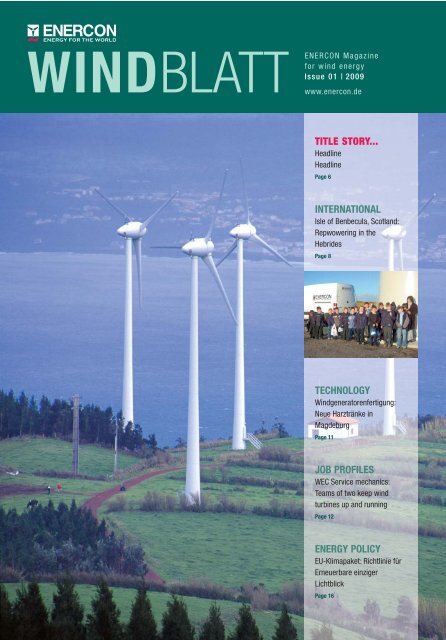
![[PDF] WB 02-2013 deu web - Enercon](https://img.yumpu.com/23394578/1/190x253/pdf-wb-02-2013-deu-web-enercon.jpg?quality=85)
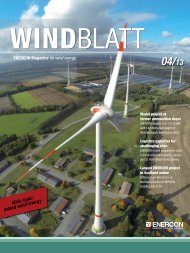

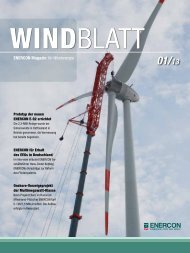
![[PDF] WB 04-2013 deu web - Enercon](https://img.yumpu.com/22304561/1/190x253/pdf-wb-04-2013-deu-web-enercon.jpg?quality=85)
